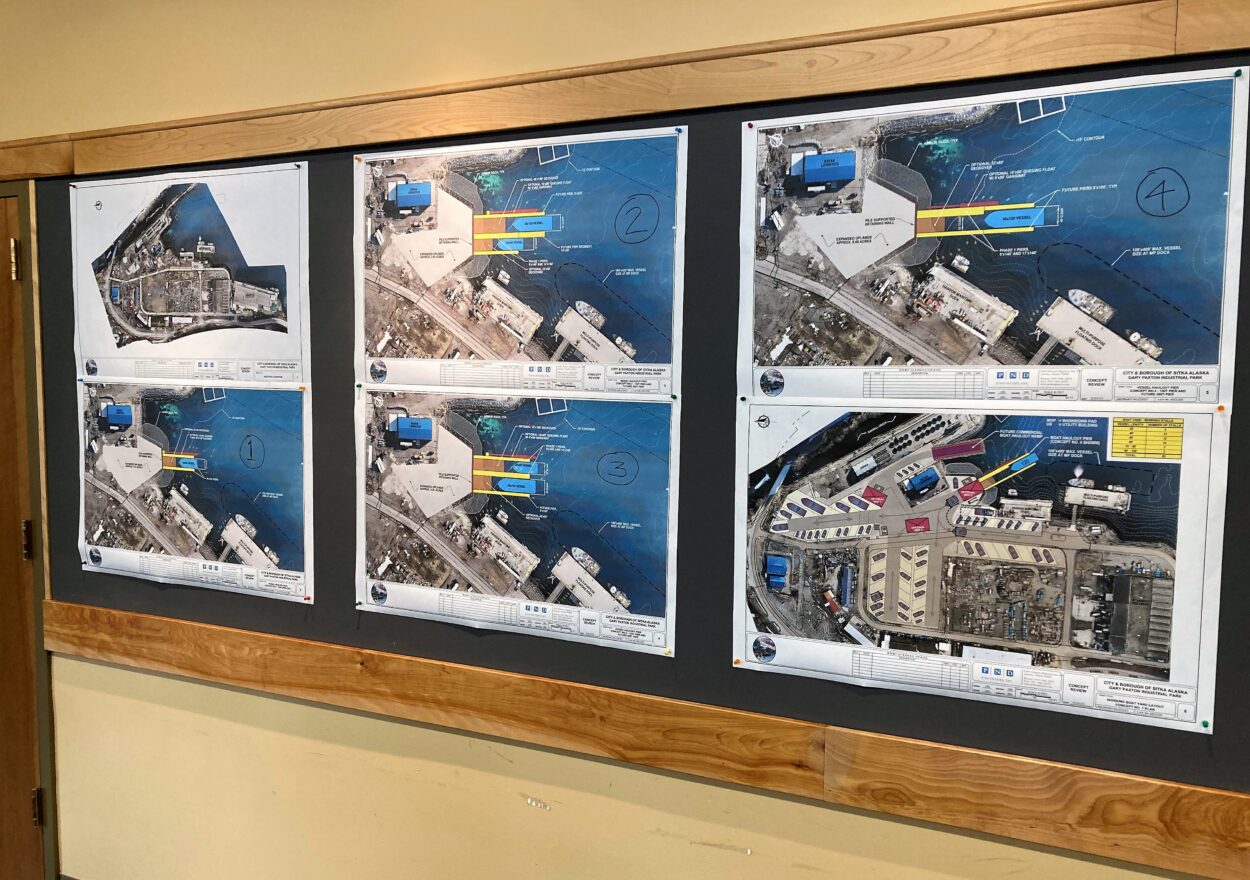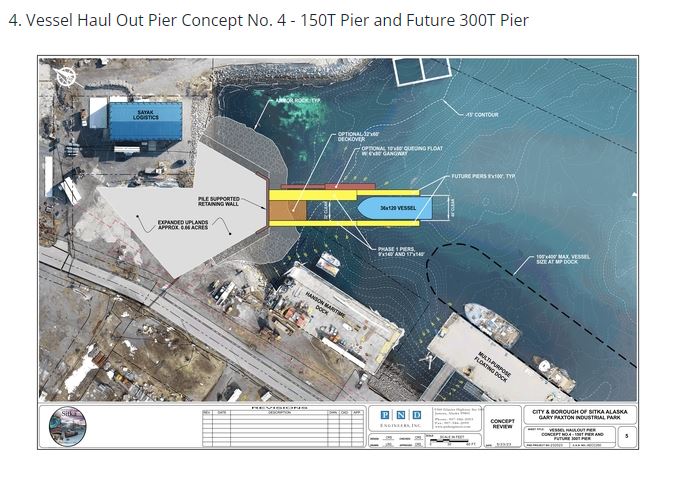
Sitka voters last October approved spending over $8 million in public funds to build a new marine haulout – but even that much money is not quite enough to get the job done.
A group of subject matter experts convened on Thursday (6-1-23) to run the numbers, and to figure out just how much $8 million will buy.
Note: The Gary Paxton Board of directors will review the four proposed concepts – and recommend one to the Sitka Assembly – at its next meeting, 3 p.m. June 22 in Harrigan Centennial Hall.
$8.2 million seems really doable for a pier and a big machine – called a travelift – to pluck boats out of the water. The problem comes when design and environmental permitting costs are accounted for, as well as contingencies. That leaves around $6 million for actual construction of the pier plus a small boatyard, installation of washdown pads and a water treatment system, and the purchase of the machine, which itself can run over $1 million.
So the question becomes: Scale back and make something happen now, or look for additional funding to build something that not only works now, but could be expanded to accommodate more – and larger – boats in the future?
There’s not enough money on hand to do either, as PND lead engineer Dick Somerville pointed out when he caught a mistake in a spreadsheet.
“Not a big deal. It’s all over budget anyway,” Somerville mused.
Twenty years ago, Wrangell was in a similar position, but counting on a new boatyard to revitalize its economy.
Greg Meissner was the Wrangell harbormaster at the time. He’s consulting now with PND Engineering on the Sitka project. He was at the table for the Sitka meeting on June 1, where stakeholders discussed whether to move forward with a desperately-needed 150-ton travelift, or plan for something bigger.
“We had the same mentality (in Wrangell),” said Meissner. “Get something and get it running, make some money, we’ll go from there. But before we even got things built, we realized we needed a bigger machine. We were looking at 100-ton back in the day, then we got to a 150. And we realized … was the bigger the boat, the more the project is…. You pull a gillnetter out, the guy’s working on it himself, unless someone’s doing some major work on the thing. You put a 90-footer in the yard, there’s three people working on that thing for some company that’s spinning a lot more revenue into the community, whether it’s taxes or your dollar rolling over– whatever it is. So you want that bigger boat.”
Sitka stakeholders looked at four concepts for a pier, travelift, and boatyard. Two of them include an extra pier for a future 300-ton travelift, and one of them – Concept 4 – has a somewhat heftier pier for a 150-ton travelift, that could one day be extended to accommodate a 300-ton travelift.

Marine tradesman Jeremy Serka said that a 150-ton machine would cover the vast majority of Sitka’s fleet, but he was intrigued by the opportunity for expansion.
Sitka municipal administrator John Leach reined in the discussion, before it strayed too far from the intent of last October’s overwhelming vote in favor of a public haulout and boatyard.
“The goal was not to be a revenue-generator,” said Leach. “We’re going to use our citizens’ money, their tax dollars, to develop a yard that serves our local fleet and our local fishermen. So if we start talking down the road in terms of revenue generation, we know that the smaller pier and the 150 ton lift serves – I think, by the analysis we’ve done over the years – it’s like 97-some odd percent of the local fleet.”
Sitka industrial park director Garry White, meanwhile, had his calculator out and was projecting costs. The results suggested that aiming for something a bit better than bare bones would not be a deal-breaker.
“To go to go from option one, which is the cheapest, to go to option four, the difference is about $684,000,” said White. “And so the question is: Is it worth the plan for the future for $684,000 to grab those bigger ships?”
And where to put those boats once they’re out of the water? Stakeholders reckoned with the number and location of washdown pads, as well as drainage in the boatyard itself, where according to municipal engineer Michael Harmon, “every drop of water” has to be collected and treated. Sitka’s industrial park has plenty of room for boats in the 40-60 foot range, but grading and storm drains could run over $1 million. Harmon urged stakeholders to think about “value trades” in the budget, and sacrifice some upland development in order to build the needed infrastructure and buy the equipment to haul out boats.
The presentation from PND Engineers contained columns of numbers, but none of them, unfortunately, added up to the $8.2 million approved by Sitka voters last October. Depending on the options, the project is short anywhere from roughly $4- to $8 million. Administrator Leach said that Sen. Lisa Murkowski had included a $2 million earmark for Sitka in an upcoming bill, but whether it will pass is uncertain. He also said the city was applying for grant funding to help close the gap.
Nevertheless, PND is moving ahead with geotechnical work, which it hopes to complete by the end of this year. If the environmental permitting works out – and of course, the money – the project could break ground next year, and be operational by January 1, 2025.






























